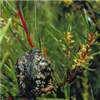Synonymy
Hakea pachyphylla Sieber ex Spreng., Syst. Veg. 16th edn, 4(2) Cur. Post. 46 (1827)
Hakea pachyphylla Schult. & Schult.f., Mant. 3: 282 (July–Dec. 1827), nom. illeg., non Sieber ex Spreng. (Jan.–June 1827). T: New Holland, 1825, F.W.Sieber 11; lecto: MEL, fide W.R.Barker, J. Adelaide Bot. Gard. 17: 204 (1996); isolecto or remaining syn: B, BR, G, G-DC, K, L, M, MEL, MO, NY. An image of the NY type specimen can be seen on the New York Botanical Garden site.
[Hakea propinqua auct. non A.Cunn.: G.Bentham, Fl. Austral. 5: 513 (1870), p.p.]
Description
Compact to spreading or depauperate single-stemmed shrub, 0.3–2 m high, non-lignotuberous. Branchlets ribbed, densely appressed-pubescent, quickly glabrescent or persistent to flowering, mid-red when young. Leaves rigid, terete, sometimes grooved below, (1–) 1.8–3.5 (–5.5) cm long, 1.1–1.8 mm wide, sparsely appressed-pubescent, quickly glabrescent; mucro c. 0.5–1.5 mm long.
Inflorescence with (1–) 3–6 (–7) flowers; rachis simple, 0.5–1.2 mm long, densely white woolly-tomentose. Flowers yellow; pedicels 1.8–3.3 mm long, moderately densely woolly-tomentose. Perianth 1.5–2 mm long, glabrous or sparsely tomentose. Pistil (3.5–) 4.2–4.5 mm long; gland minute.
Fruit woody, remaining closed, elliptic, coarsely bluntly tuberculate, 2.9–3.5 cm long, 2.3–2.6 cm wide; beak tuberculate, short and broad, decurrent unequally down both sides of fruit body; horns obscure or absent. Seed displaced from centre, not marginal, elliptic to obliquely obovate, 22–25 mm long, 10–12 mm wide; wing decurrent broadly 1/2–3/4 way down one side only, deep brown.
Distribution and ecology
Occurs in the Blue Mtns, N.S.W., in a variety of habitats from swamp to heath or mallee-heath, sometimes on sandstone.
To plot an up to date distribution map based on herbarium collections for this species see Australia's Virtual Herbarium. Localities outside the native range may represent cultivated or naturalised records.
Flowering time
Flowers Aug.–Sept. (–Oct.).
Derivation of name
From pachys, Greek for thick or stout and phyllon, Greek for leaf, a reference to the thickness of the leaves of this species.
Relationships
Part of Section Hakea of Bentham (as Euhakea) and characterised by a non-conical pollen presenter, leaves without obvious venation, perianths with or without hairs and fruits with or without horns. Barker et al. (1999) recognised a number of informal morphological groups within the section.
The Nodosa group consists of only 3 species, H. nodosa, H. propinqua and H. pachyphylla. Close to the Sericea group and sharing the simple needle leaves, few-flowered inflorescences, hairy pedicels and woody tuberculate fruits but differing in their very small flowers in which the pistil is only 3-4.5 mm long. H. nodosa does sometimes produce flattened, rather than terete, leaves and can also produce non-woody fruits as well as the distinctive woody fruits. All 3 species occur in the eastern states of Australia.
Notes
While documented as confined to the Blue Mountains region there are three specimens resembling H. pachyphylla from the northern Budawang Ra. (Pulley & Telford BR75, Carolin 7055) and the adjacent Little Forest Plateau (Mills NSW223475). The specimens match H. pachyphylla in fruit surface, shape and beak, and in the robust leaves, but population samples, including flowers, are required to confirm the identification.
H. pachyphylla is often confused with H. propinqua which differs in its lower Blue Mtns distribution, conifer-like habit, May-July flowering, white flowers and larger fruit with more regular and sharper outgrowths.
Representative specimens
N.S.W.: Du Faurs Rocks, Blue Mtns, W.A.Barker 5672 (AD); L. Medlow, 5 km NNW of Katoomba, E.F.Constable 6107 (NSW); Kings Tableland, S of Wentworth Falls, R.Melville 646 & L.A.S.Johnson (AD, BRI, MEL).
Weblinks
Link to PlantNET treatment.
More photographs of this species can be seen on the Australian National Botanic Gardens site, although these photographs with their white flowers are perhaps more suggestive of H. propinqua .
Wikipedia:http://en.wikipedia.org/wiki/Image:Hakea_pachyphylla.JPG#filelinks


